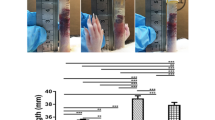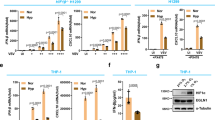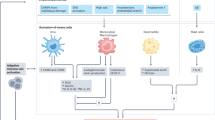Abstract
Hypertension induced by hypoxia at high altitude is one of the typical symptoms of high-altitude reactions (HARs). Emerging evidence indicates that endothelial abnormalities, including increases in angiotensin-2 (Ang-2) and endothelin-1 (ET-1), are closely associated with hypertension. Thus, low blood oxygen-induced endothelial dysfunction through acceleration of Ang-2 and ET-1 synthesis may alleviate HARs. In this study, we investigated the effects of hypoxia on rat blood pressure (BP) and endothelial injury. We found that BP increased by 10 mmHg after treatment with 10% O2 (~5500 m above sea level) for 24 h. Consistently, serum Ang-2 and ET-1 levels were increased along with decreases in NO levels. In endothelial cells, angiotensin-1-converting enzyme (ACE) and ET-1 expression levels were upregulated. Interestingly, nuclear respiratory factor 1 (NRF1) levels were also upregulated, consistent with the changes in ACE and ET-1 levels. We further demonstrated that NRF1 transcriptionally activated ACE and ET-1 by directly binding to their promoter regions, suggesting that the endothelial cell dysfunction induced by hypoxia was due to NRF1-dependent upregulation of ACE and ET-1. Surprisingly, testosterone supplementation showed significant protective effects on BP, while castration induced even higher BPs in rats exposed to hypoxia. We further showed that physiological testosterone repressed NRF1 expression in vivo and in vitro and thereby reduced Ang-2 and ET-1 levels, which was dependent on hypoxia. In summary, we have identified that physiological testosterone protects against hypoxia-induced hypertension through inhibition of NRF1, which transcriptionally regulates ACE and ET-1 expression.
This is a preview of subscription content, access via your institution
Access options
Subscribe to this journal
Receive 12 print issues and online access
$259.00 per year
only $21.58 per issue
Buy this article
- Purchase on Springer Link
- Instant access to full article PDF
Prices may be subject to local taxes which are calculated during checkout





Similar content being viewed by others
References
Disease EC, Tomelleri A, Cavalli G, Berti A, Dagna L. Erdheim-Chester disease. Eur J Intern Med. 2015;26:223–9.
Kropfl JM, Kammerer T, Faihs V, Gruber HJ, Stutz J, Rehm M, et al. Acute exercise in hypobaric hypoxia attenuates endothelial shedding in subjects unacclimatized to high altitudes. Front Physiol. 2019;10:1632.
Wolfel EE, Selland MA, Mazzeo RS, Reeves JT. Systemic hypertension at 4,300 m is related to sympathoadrenal activity. J Appl Physiol. 1994;76:1643–50.
Mazzeo RS, Carroll JD, Butterfield GE, Braun B, Rock PB, Wolfel EE, et al. Catecholamine responses to alpha-adrenergic blockade during exercise in women acutely exposed to altitude. J Appl Physiol. 2001;90:121–6.
Bilo G, Caldara G, Styczkiewicz K, Revera M, Lombardi C, Giglio A, et al. Effects of selective and nonselective beta-blockade on 24-h ambulatory blood pressure under hypobaric hypoxia at altitude. J Hypertens. 2011;29:380–7.
Grocott M. Commentary. J Intensive Care Soc. 2012;13:204–5.
Santos RA, Ferreira AJ, Ac SES. Recent advances in the angiotensin-converting enzyme 2-angiotensin(1-7)-Mas axis. Exp Physiol. 2008;93:519–27.
Narvaez-Guerra O, Herrera-Enriquez K, Medina-Lezama J, Chirinos JA. Systemic hypertension at high altitude. Hypertension. 2018;72:567–78.
Wood KC, Liu VB, Noguchi A, Wang XD, Raghavachari N, Gladwin MT. Blood cell versus vascular endothelial cell contributions to nitrite homeostasis and blood pressure regulation. Free Radic Biol Med. 2008;45:S118–9.
Rickard AJ, Morgan J, Chrissobolis SB, Miller AA, Sobey CG, Young MJ. Endothelial cell mineralocorticoid receptors regulate deoxycorticosterone/salt-mediated cardiac remodeling and vascular reactivity, but not blood pressure. Hypertension. 2014;63:E160
Amiri F, Paradis P, Reudelhuber TL, Schiffrin EL. Vascular inflammation in absence of blood pressure elevation in transgenic murine model overexpressing endothelin-1 in endothelial cells. J Hypertens. 2008;26:1102–9.
Chuaiphichai S, Rashbrook VS, Hale AB, Trelfa L, Mcneill E, Lygate CA, et al. Deficiency in endothelial cell tetrahydrobiopterin increases resistance vascular remodelling, blood pressure, and susceptibility to aortic abdominal aneurysm in response to angiotensin II. Cardiovasc Res. 2018;114:S90.
Ten VS, Pinsky DJ. Endothelial response to hypoxia: physiologic adaptation and pathologic dysfunction. Curr Opin Crit Care. 2002;8:242–50.
Baldea I, Teacoe I, Olteanu DE, Vaida-Voievod C, Clichici A, Sirbu A, et al. Effects of different hypoxia degrees on endothelial cell cultures—time course study. Mech Ageing Dev. 2018;172:45–50.
Michiels C, Arnould T, Remacle J. Endothelial cell responses to hypoxia: initiation of a cascade of cellular interactions. Biochim Biophys Acta. 2000;1497:1–10.
Adam T, Makaula S, Essop MF. Nuclear respiratory factor 1: a novel inhibitor of the human gene promoter of the cardiac isoform of acetyl-coa carboxylase. Cardiovasc Drug Ther. 2006;20:396.
Scarpulla R. Transcriptional paradigms in mammalian mitochondrial biogenesis and function. Physiol Rev. 2008;88:611–38.
Tiranti V, Rossi E, Rocchi M, Didonato S, Zuffardi O, Zeviani M. The gene (NFE2L1) for human NRF-1, an activator involved in nuclear-mitochondrial interactions, maps to 7q32. Genomics. 1995;27:555–7.
Scarpulla RC. Nuclear respiratory factors and the pathways of nuclear-mitochondrial interaction. Trends Cardiovas Med. 1996;6:39–45.
Jun-Ichi S, Natsuki K, Yoji Y. Pathway analysis of ChIP-seq-based NRF1 target genes suggests a logical hypothesis of their involvement in the pathogenesis of neurodegenerative diseases. Gene Regul Syst Biol. 2013;7:139–52.
Wang D, Zhang J, Lu Y, Luo Q, Zhu L. Nuclear respiratory factor-1 (NRF-1) regulated hypoxia-inducible factor-1alpha (HIF-1alpha) under hypoxia in HEK293T. IUBMB Life. 2016;68:748–55.
Wang X, Jin L, Jiang S, Wang D, Lu Y, Zhu L. Transcription regulation of NRF1 on StAR reduces testosterone synthesis in hypoxemic murine. J Steroid Biochem Mol Biol. 2019;191:105370.
Webb CM, Mcneill JG, Hayward CS, Zeigler D, De, Collins P. Effects of testosterone on coronary vasomotor regulation in men with coronary heart disease. Circulation. 1999;100:1690–6.
Lauro FV, Hector L, Carlos CH, Olga MOG, Tomas MC, Guillermo CR. Synthesis and evaluation of the cardiovascular effects of two, membrane impermeant, macromolecular complexes of dextran-testosterone. Steroids. 2002;67:611–9.
Villar IC, Francis S, Webb A, Hobbs AJ, Ahluwalia A. Novel aspects of endothelium-dependent regulation of vascular tone. Kidney Int. 2006;70:840–53.
Montalcini T, Gorgone G, Gazzaruso C, Sesti G, Perticone F, Pujia A. Endogenous testosterone and endothelial function in postmenopausal women. Coron Artery Dis. 2007;18:9.
Suzuki T, Nakamura Y, Moriya T, Sasano H. Effects of steroid hormones on vascular functions. Microsc Res Tech. 2010;60:76.
Yildiz O, Seyrek M. Vasodilating mechanisms of testosterone. Exp Clin Endocrinol Diabetes. 2007;115:1–6.
Wang X, Pan L, Zou Z, Wang D, Lu Y, Dong Z, et al. Hypoxia reduces testosterone synthesis in mouse Leydig cells by inhibiting NRF1-activated StAR expression. Oncotarget. 2017;8:16401–13.
Wang X, Zou Z, Yang Z, Jiang S, Lu Y, Wang D, et al. HIF 1 inhibits StAR transcription and testosterone synthesis in murine Leydig cells. J Mol Endocrinol. 2018;62:1–12.
Wang X, Huang L, Jiang S, Cheng K, Wang D, Luo Q, et al. Testosterone attenuates pulmonary epithelial inflammation in male rats of COPD model through preventing NRF1-derived NF-kappaB signaling. J Mol Cell Biol. 2021;13:128–140.
Hotta Y, Kataoka T, Kimura K. Testosterone deficiency and endothelial dysfunction: nitric oxide, asymmetric dimethylarginine, and endothelial progenitor cells. Sex Med Rev. 2019;7:661–8.
Marin R, Escrig A, Abreu P, Mas M. Androgen-dependent nitric oxide release in rat penis correlates with levels of constitutive nitric oxide synthase isoenzymes. Biol Reprod. 1999;61:1012–6.
Elesber AA, Solomon H, Lennon RJ, Mathew V, Prasad A, Pumper G, et al. Coronary endothelial dysfunction is associated with erectile dysfunction and elevated asymmetric dimethylarginine in patients with early atherosclerosis. Eur Heart J. 2006;27:824–31.
Kumanov P, Tomova A, Kirilov G, Dakovska L, Schinkov A. Increased plasma endothelin levels in patients with male hypogonadism. Andrologia. 2002;34:29–33.
Zhang HL, Yue ZP, Zhang L, Yang ZQ, Geng S, Wang K, et al. Expression and regulation of angiopoietins and their receptor Tie-2 in sika deer antler. Anim Cells Syst. 2017;21:177–84.
Gassmann M, Cowburn A, Gu H, Li J, Rodriguez M, Babicheva A, et al. Hypoxia-induced pulmonary hypertension—utilizing experiments of nature. Br J Pharm. 2021;178:121–31.
Nanduri J, Peng YJ, Yuan G, Kumar GK, Prabhakar NR. Hypoxia-inducible factors and hypertension: lessons from sleep apnea syndrome. J Mol Med. 2015;93:473–80.
Chaouat A, Naeije R, Weitzenblum E. Pulmonary hypertension in COPD. Eur Respir J. 2008;32:1371–85.
Yamashita K, Discher DJ, Hu J, Bishopric NH, Webster KA. Molecular regulation of the endothelin-1 gene by hypoxia. Contributions of hypoxia-inducible factor-1, activator protein-1, GATA-2, AND p300/CBP. J Biol Chem. 2001;276:12645–53.
Zhang R, Wu Y, Zhao M, Liu C, Zhou L, Shen S, et al. Role of HIF-1alpha in the regulation ACE and ACE2 expression in hypoxic human pulmonary artery smooth muscle cells. Am J Physiol Lung Cell Mol Physiol. 2009;297:L631–40.
Xiao F, Li X, Wang J, Cao J. Mechanisms of vascular endothelial cell injury in response to intermittent and/or continuous hypoxia exposure and protective effects of anti-inflammatory and anti-oxidant agents. Sleep Breath. 2019;23:515–22.
Flamant L, Toffoli S, Raes M, Michiels C. Hypoxia regulates inflammatory gene expression in endothelial cells. Exp Cell Res. 2009;315:733–47.
Suliman HB, Sweeney TE, Withers CM, Piantadosi CA. Co-regulation of nuclear respiratory factor-1 by NFkappaB and CREB links LPS-induced inflammation to mitochondrial biogenesis. J Cell Sci. 2010;123:2565–75.
Dalmasso C, Patil CN, Yanes Cardozo LL, Romero DG, Maranon RO. Cardiovascular and metabolic consequences of testosterone supplements in young and old male spontaneously hypertensive rats: implications for testosterone supplements in men. J Am Heart Assoc. 2017;6:10.
Velho I, Fighera TM, Ziegelmann PK, Spritzer PM. Effects of testosterone therapy on BMI blood pressure, laboratory profile of transgender men: a systematic review. Andrology. 2017;5:881–8.
Kienitz T, Quinkler M. Testosterone and blood pressure regulation. Kidney Blood Press Res. 2008;31:71–9.
Traish A, Bolanos J, Nair S, Saad F, Morgentaler A. Do androgens modulate the pathophysiological pathways of inflammation? Appraising the contemporary evidence. J Clin Med. 2018;7:12.
Lee OD, Tillman K. An overview of testosterone therapy. Am J Mens Health. 2016;10:68–72.
Lo EM, Rodriguez KM, Pastuszak AW, Khera M. Alternatives to testosterone therapy: a review. Sex Med Rev. 2018;6:106–13.
Ohlander SJ, Varghese B, Pastuszak AW. Erythrocytosis following testosterone therapy. Sex Med Rev. 2018;6:77–85.
Acknowledgements
The authors thank Professor Xia Li at Nantong University, who kindly provided the HUVEC line as a gift. In addition, the authors thank Dr. Zhangji Dong at Nantong University for polishing the manuscript.
Funding
The study was supported by the National Natural Science Foundation of China (31671206, 81702874).
Author information
Authors and Affiliations
Corresponding authors
Ethics declarations
Conflict of interest
The authors declare no competing interests.
Additional information
Publisher’s note Springer Nature remains neutral with regard to jurisdictional claims in published maps and institutional affiliations.
Supplementary information
Rights and permissions
About this article
Cite this article
Jiang, S., Chen, G., Yang, Z. et al. Testosterone attenuates hypoxia-induced hypertension by affecting NRF1-mediated transcriptional regulation of ET-1 and ACE. Hypertens Res 44, 1395–1405 (2021). https://doi.org/10.1038/s41440-021-00703-4
Received:
Revised:
Accepted:
Published:
Issue Date:
DOI: https://doi.org/10.1038/s41440-021-00703-4
Keywords
This article is cited by
-
Transcriptional regulation of NRF1 on metabotropic glutamate receptors in a neonatal hypoxic‑ischemic encephalopathy rat model
Pediatric Research (2023)
-
Transcriptomic analysis of the cerebral hippocampal tissue in spontaneously hypertensive rats exposed to acute hypobaric hypoxia: associations with inflammation and energy metabolism
Scientific Reports (2023)
-
Caveolin-1 accelerates hypoxia-induced endothelial dysfunction in high-altitude cerebral edema
Cell Communication and Signaling (2022)
-
Sex-dependent blood pressure regulation in acute hypoxia
Hypertension Research (2021)
-
Reply to a letter to the Editor regarding the article “Testosterone attenuates hypoxia-induced hypertension by affecting NRF1-mediated transcriptional regulation of ET-1 and ACE”
Hypertension Research (2021)



